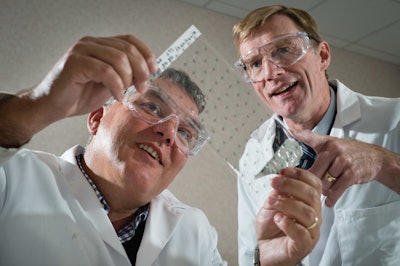
Researchers at the University of Warwick (U.K.) worked with Coventry-based Medherant, a Warwick spinout company, to produce and patent what reportedly is the world’s first-ever ibuprofen patch delivering the drug directly through skin to exactly where it is needed at a consistent dose rate.
The transparent adhesive patch is designed to consistently deliver a prolonged high dose of the painkiller ibuprofen. The University of Warwick researchers and Medherant incorporate significant amounts of the drug (up to 30% weight) into the polymer matrix that sticks the patch to the patient’s skin with the drug then being delivered at a steady rate over up to 12 hr.
The development is said to pave the way for the development of a range of novel long-acting over-the-counter pain relief products for use to treat common painful conditions such as chronic back pain, neuralgia and arthritis—without the need to take potentially damaging doses of the drug orally.
Although there are popular ibuprofen gels available, these make it difficult to control dosage and are inconvenient to apply, according to the patch developers.
The novel patch incorporates polymer technology developed by global adhesive company Bostik and is exclusively licensed for transdermal use to Medherant.
Key features of Medherant’s new patch technology include the following:
• The patch remains highly tacky and adheres well to skin even when the drug load reaches levels as high as 30% of the weight/volume of the patch. The drug load made possible by this new technology can be five-to-10-times that found in some currently used medical patches and gels.
• High drug load and a consistent drug release profile allow the patches to deliver a consistent and significant dose of drug over a prolonged time from a small patch.
• Uses a cosmetically pleasing transparent design with strong adhesion that remains stuck over its time of action, yet is easy and comfortable to remove.
University of Warwick Research Chemist Professor David Haddleton says, “Many commercial patches surprisingly don’t contain any pain relief agents at all, they simply soothe the body by a warming effect. Our technology means that we can for the first time produce patches that contain effective doses of active ingredients such as ibuprofen for which no patches currently exist. Also, we can improve the drug loading and stickiness of patches containing other active ingredients to improve patient comfort and outcome.”
He adds, “There are only a limited number of existing polymers that have the right characteristics to be used for this type of transdermal patches—that will stick to the skin and not leave residues when being easily removed. Furthermore, there are also only a limited number of drugs that will dissolve into these existing polymers. Medherant’s technology now opens up the field of transdermal drug delivery to previously non-compatible drugs.”
Nigel Davis, Medherant’s CEO adds, “Our transdermal patch technology expands the range of drugs that can be delivered via skin patches and can significantly increase drug loading capabilities, whilst retaining adhesion and being thin and flexible.
“Our first products will be over-the-counter pain relief patches and through partnering we would expect to have the first of those products on the market in around two years. In addition to our pain relief products, our technology also works with drugs in many other therapeutic areas. We can see considerable opportunities in working with pharmaceutical companies to develop innovative products using our next-generation transdermal drug-delivery platform.”






















